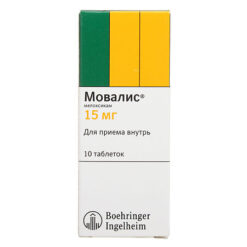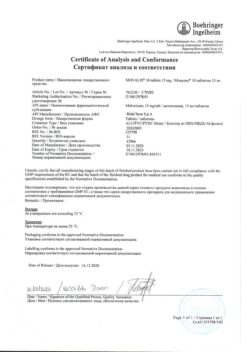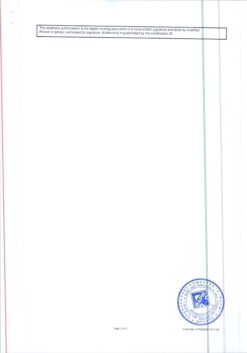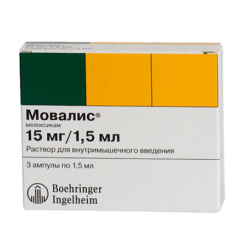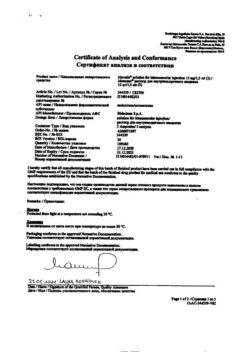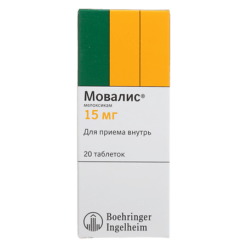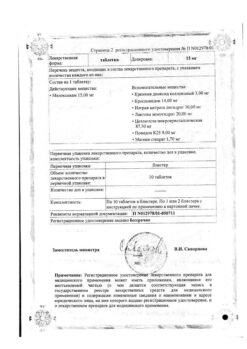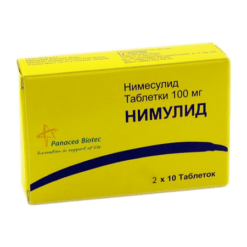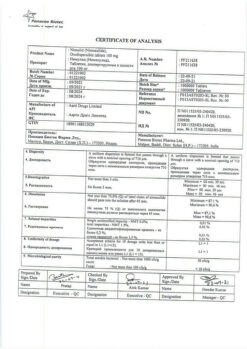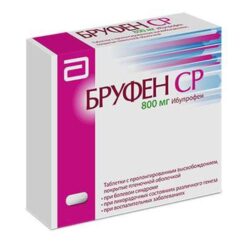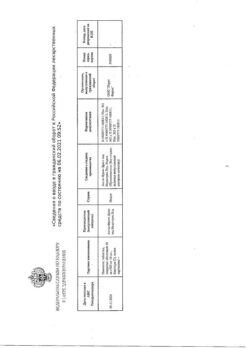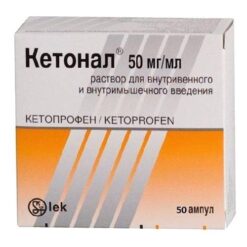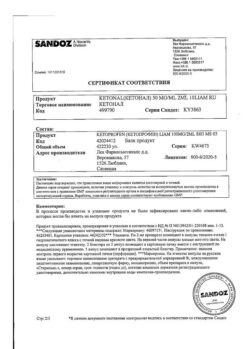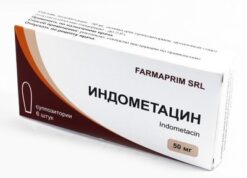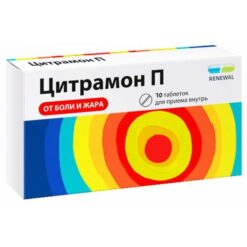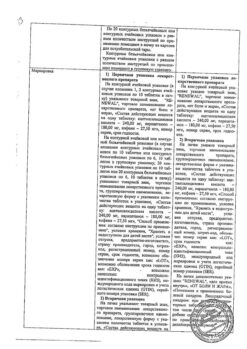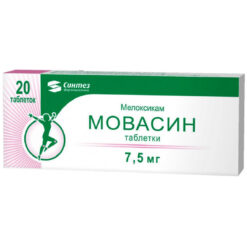No products in the cart.
Movalis, tablets 7.5 mg 20 pcs
€22.78 €18.98
Description
Pharmgroup:
NSAIDs.
Pharmic action:
Movalis is a non-steroidal anti-inflammatory drug, refers to enolic acid derivatives and has anti-inflammatory, analgesic and antipyretic effects. The pronounced anti-inflammatory effect of meloxicam was established in all standard models of inflammation. The mechanism of action of meloxicam is its ability to inhibit the synthesis of prostaglandins – known mediators of inflammation.
In vivo meloxicam inhibits the synthesis of prostaglandins at the site of inflammation to a greater extent than in the gastric mucosa or kidneys. These differences are due to more selective inhibition of cyclooxygenase-2 (COX-2) compared to cyclooxygenase-1 (COX-1). Inhibition of COX-2 is thought to provide the therapeutic effect of NSAIDs, whereas inhibition of the ever-present COX-1 isoenzyme may cause gastric and renal side effects.
The selectivity of meloxicam against COX-2 has been confirmed in various test systems, both in vitro and ex vivo. The selective ability of meloxicam to inhibit COX-2 was shown when using human whole blood as a test system in vitro. Ex vivo, meloxicam (at doses of 7.5 and 15 mg) was found to be more active in inhibiting COX-2, having a greater inhibitory effect on lipopolysaccharide-stimulated prostaglandin E2 production (COX-2-controlled response) than on thromboxane production involved in blood clotting (COX-1-controlled response). These effects were dose-dependent.
Ex vivo it has been shown that meloxicam at the recommended doses had no effect on platelet aggregation and bleeding time, unlike indomethacin, diclofenac, ibuprofen and naproxen, which significantly inhibited platelet aggregation and increased bleeding time.
In clinical trials, gastrointestinal (GI) side effects were generally less frequent with meloxicam 7.5 and 15 mg than with the other NSAIDs compared. This difference in the frequency of gastrointestinal side effects is mainly due to the fact that such phenomena as dyspepsia, vomiting, nausea, and abdominal pain were observed less frequently while taking meloxicam. The frequency of upper gastrointestinal perforations, ulcers and bleeding associated with the use of meloxicam was low and depended on the size of the dose of the drug.
Pharmacokinetics:
Meloxicam is well absorbed from the gastrointestinal tract, as evidenced by high absolute bioavailability when taken orally (89%).
On single administration of Movalis in tablet form the average maximum concentration in plasma is reached within 5-6 hours. With multiple administration a steady state pharmacokinetics is reached within 3 to 5 days.
The range of differences between maximum (Cmax) and basal concentrations (Cmin) of the drug during steady state pharmacokinetics after its administration once daily is relatively small and is 0.4-1.0 µg/ml – for 7.5 mg dose, and 0.8-2.0 µg/ml – for 15 mg dose. Maximum plasma concentrations during steady state pharmacokinetics are reached within 5-6 hours when tablets are taken.
The concentrations of the drug, after continuous administration for more than 6 months, are similar to those observed after 2 weeks of oral administration of 15 mg daily. Such differences are unlikely when taken over 6 months.
Concurrent food intake does not affect absorption of the drug.
Movalis suppositories:
Suppositories have been shown to be bioequivalent to tablets. The maximum concentration of the drug in plasma during steady state pharmacokinetics is reached approximately 5 hours after administration of the drug. The ranges of differences between the maximum (Cmax) and basal concentrations (Cmin) are similar for tablets and suppositories.
Distribution
Meloxicam binds well to plasma proteins (with albumin – 99%) Meloxicam penetrates the synovial fluid; local concentrations are approximately 50% of plasma concentrations. The volume of distribution is low, averaging 11 L. Individual variation is 30-40%.
Metabolism
Meloxicam is almost completely metabolized in the liver to form 4 pharmacologically inactive derivatives, detectable in urine. The main metabolite, 5′-carboxymeloxicam (60% of the dose value), is formed by oxidation of the intermediate metabolite, 5′-hydroxymethylmeloxicam, which is also excreted, but to a lesser extent (9% of the dose value). In vitro studies have shown that CYP 2C9 plays an important role in this metabolic transformation, CYP 3A4 isoenzyme has additional importance. Peroxidase, the activity of which probably varies individually, is involved in the formation of the other two metabolites (constituting, respectively, 16% and 4% of the drug dose).
It is excreted equally in the feces and urine, mainly as metabolites. Less than 5% of daily dose is excreted unchanged in feces, in urine the drug is excreted unchanged only in trace amounts. The average half-life of meloxicam is 20 hours.
Plasma clearance averages 8 ml/min. Meloxicam shows linear pharmacokinetics at doses of 7.5 – 15 mg when taken orally.
Hepatic and/or renal function deficiencies
Liver function deficiencies and mild to moderate renal insufficiency have no significant effect on the pharmacokinetics of meloxicam.
In terminal renal failure, increased volume of distribution may lead to higher concentrations of free meloxicam, so in these patients the daily dose should not exceed 7.5 mg.
Elderly patients
The average plasma clearance during steady state pharmacokinetics is slightly lower in elderly patients than in younger patients.
During a study of meloxicam in children, the pharmacokinetics of the drug were studied in doses administered at 0.25 mg/kg. When comparing indices in children of different ages (2-6 years, n = 7 and 7-14 years, n = 11), a tendency to lower maximum plasma concentrations (Cmax, -34%) and AUC0-∞ (-28%) in younger children was found, while drug clearance (adjusted for body weight) was higher in this group of children. Plasma concentrations of meloxicam in older children and adults were similar. In children of both age groups the half-lives of meloxicam from plasma were similar (13 hours) and slightly shorter than in adults (15-20 hours).
Indications
Indications
Symptomatic treatment:
Active ingredient
Active ingredient
Composition
Composition
Active substance:
Meloxicam7.5 mg;
Associates:
sodium citrate;
lactose;
MC;
povidone (collidon 25),
colloidal silicon dioxide;
crospovidone;
magnesium stearate.
How to take, the dosage
How to take, the dosage
Overly, with meals, with water or other liquids; rectally.
Osteoarthritis, rheumatoid arthritis – 7.5 mg/day. If necessary, this dose can be increased to 15 mg/day. Depending on the therapeutic effect, this dose can be reduced to 7.5 mg/day.
Ankylosing spondylitis – 15 mg/day. Depending on the therapeutic effect, this dose may be reduced to 7.5 mg/day.
In patients with an increased risk of adverse reactions, it is recommended to start treatment with a dose of 7.5 mg/day. For patients with significant renal impairment who are on hemodialysis, the dose should not exceed 7.5 mg/day.
Adolescents
The maximum dose for adolescents is 0.25 mg/kg.
In general, the drug should only be used in adolescents and adults (see Contraindications section). The maximum recommended daily dose is 15 mg.
Rectal suppositories are recommended at a dose of 7.5 mg once daily. In more severe cases, a 15-mg dose of suppositories may be used.
Because the risk of adverse reactions depends on the size of the dose and the duration of use, the drug should be used for the shortest possible time at the lowest possible effective dose.
Combined use. The total daily dose of Movalis® used as tablets, suppositories, injections should not exceed 15 mg.
Interaction
Interaction
Other GH synthesis inhibitors, including GK and salicylates, when taken concomitantly with meloxicam increase the risk of gastrointestinal ulcers and bleeding (due to synergistic action) and therefore their combination is not recommended. Simultaneous use with other NSAIDs is not recommended.
SIOZS – increased risk of gastrointestinal bleeding.
Lithium drugs – NSAIDs increase plasma lithium concentrations by reducing renal excretion. It is recommended that lithium concentrations be monitored during the administration of Movalis®, when the dose of lithium drugs is changed and when they are withdrawn.
Methotrexate – NSAIDs decrease tubular secretion of methotrexate, thereby increasing its plasma concentrations and hematological toxicity, the pharmacokinetics of methotrexate is not altered. In this regard, concomitant administration of Movalis® and methotrexate in dose more than 15 mg/day is recommended. The risk of interaction between NSAIDs and methotrexate may also occur in patients using methotrexate in low doses, especially in patients with impaired renal function. Therefore, continuous monitoring of blood cell count and renal function is necessary.
The concomitant use of meloxicam had no effect on the pharmacokinetics of methotrexate at a dose of 15 mg per week, but it should be taken into account that hematological toxicity of methotrexate is increased by concomitant use of NSAIDs.
The co-administration of meloxicam and methotrexate for 3 days increases the risk of increased toxicity of the latter.
Contraception – NSAIDs reduce the effectiveness of intrauterine contraceptive devices.
Diuretics – the use of NSAIDs in patients who are dehydrated is accompanied by a risk of acute renal failure.
In patients receiving Movalis® and diuretics, adequate hydration must be maintained. Renal function should be investigated prior to initiation of treatment.
Antihypertensive agents (beta-adrenoblockers, ACE inhibitors, vasodilators, diuretics) – NSAIDs decrease the effect of antihypertensive agents, due to inhibition of PGs, which have vasodilatory properties.
Angiotensin II receptor antagonists when combined with NSAIDs increase decrease of glomerular filtration, which may lead to acute renal failure, especially in patients with impaired renal function. In case of combined therapy, renal function should be monitored.
The NSAIDs may increase the nephrotoxicity of cyclosporine by acting on renal GHGs.
When using with meloxicam medicinal products that have a known ability to inhibit CYP2C9 and/or CYP3A4 (or are metabolized with the participation of these enzymes), the possibility of pharmacokinetic interaction should be taken into account.
The possibility of interaction with hypoglycemic drugs for oral administration cannot be excluded.
When concomitant use of antacids, cimetidine, digoxin and furosemide, no significant pharmacokinetic interactions have been found.
Special Instructions
Special Instructions
Movalis should be used with caution in concomitant diseases of the upper gastrointestinal tract, as well as in patients receiving anticoagulant therapy. In case of peptic ulcer or gastrointestinal bleeding, the drug should be discontinued.
When prescribing Movalis, gastrointestinal bleeding, ulceration or perforation is possible, both with and without indications in patients’ history of previous symptoms and episodes of such GI complications. The course of these complications is more severe in the elderly.
Particular attention must be paid to patients who have had adverse effects on the skin and mucous membranes, in these cases discontinuation of Movalis should be considered.
The NSAIDs inhibit the synthesis of renal prostaglandins, which are involved in maintaining adequate renal blood flow. Administration of NSAIDs to patients with decreased renal blood flow and RBC may precipitate renal decompensation, but renal function generally returns to previous levels after NSAID therapy is discontinued.
The risk of adverse reactions is particularly high in patients with dehydration, congestive heart failure, cirrhosis, nephrotic syndrome, and severe renal disease, in patients treated with diuretics, and in patients who have undergone significant surgery resulting in hypovolemia. Such patients require careful monitoring of diuresis and renal function from the beginning of treatment.
In rare cases, elevated serum transaminases or changes in other parameters characterizing liver function have been reported. In most cases, deviations from the norm were minor and transient. If liver function abnormalities are more pronounced or persistent, the use of Movalis should be discontinued and control laboratory tests should be performed.
In patients with clinically nonadvanced cirrhosis there is no need to reduce the dose of the drug.
Weakened and debilitated patients may have more severe side effects and these patients should be closely monitored.
Movalis should be used with caution in elderly patients who are more likely to have impaired renal, hepatic or cardiac function. NSAIDs may contribute to sodium, potassium and water retention and weaken the natriuretic effect of diuretics. As a result, in the presence of predisposing factors, prescribing NSAIDs may lead to progression of heart failure and hypertension.
Impact on driving and operating machinery
During treatment, if visual acuity, dizziness or somnolence are observed, one should refrain from driving and engaging in potentially dangerous activities requiring increased concentration and quick psychomotor reactions.
Contraindications
Contraindications
Side effects
Side effects
Hematopoietic organs: changes in the number of blood cells, including changes in the leukocytic formula, leukopenia, thrombocytopenia, anemia. A predisposing factor for the occurrence of cytopenias seems to be the simultaneous use of potentially myelotoxic drugs, in particular methotrexate.
Immune system disorders: anaphylactic shock, anaphylactoid/anaphylactic reactions, other immediate-type hypersensitivity reactions.
CNS disorders: headache, dizziness, tinnitus, drowsiness, confusion, disorientation, mood changes.
Gastrointestinal disorders: Gastrointestinal perforation, hidden or overt gastrointestinal bleeding, possibly fatal, gastroduodenal ulcers, colitis, gastritis, esophagitis, stomatitis, abdominal pain, dyspepsia, diarrhea, nausea, vomiting, constipation, bloating, belching, transient changes in liver function parameters (such as increased transaminase or bilirubin activity), hepatitis.
Skin and skin appendages: toxic epidermal necrolysis, Stevens-Johnson syndrome, angioedema, bullous dermatitis, erythema multiforme, pruritus, skin rash, urticaria, photosensitization.
Respiratory system disorders: bronchial asthma in patients with allergy to acetylsalicylic acid or other NSAIDs.
Systemic diseases: increase in blood pressure, palpitations, blood rush to the face, edema.
Urogenital system disorders: acute renal failure, changes in renal function (increased serum creatinine and/or serum urea levels), urinary disorders, including acute urinary retention.
Visual organs: conjunctivitis, visual disturbances, including blurred vision.
Overdose
Overdose
Treatment: gastric lavage and standard supportive measures.
A specific antidote is unknown.
In clinical trials it has been shown that colestyramine accelerates excretion of meloxicam.
Similarities
Similarities
Additional information
| Shelf life | 5 years |
|---|---|
| Conditions of storage | In a dry place, at a temperature not exceeding 25 °C |
| Manufacturer | Boehringer Ingelheim Pharma GmbH & Co. |
| Medication form | pills |
| Brand | #Н/Д |
Other forms…
Related products
Buy Movalis, tablets 7.5 mg 20 pcs with delivery to USA, UK, Europe and over 120 other countries.


